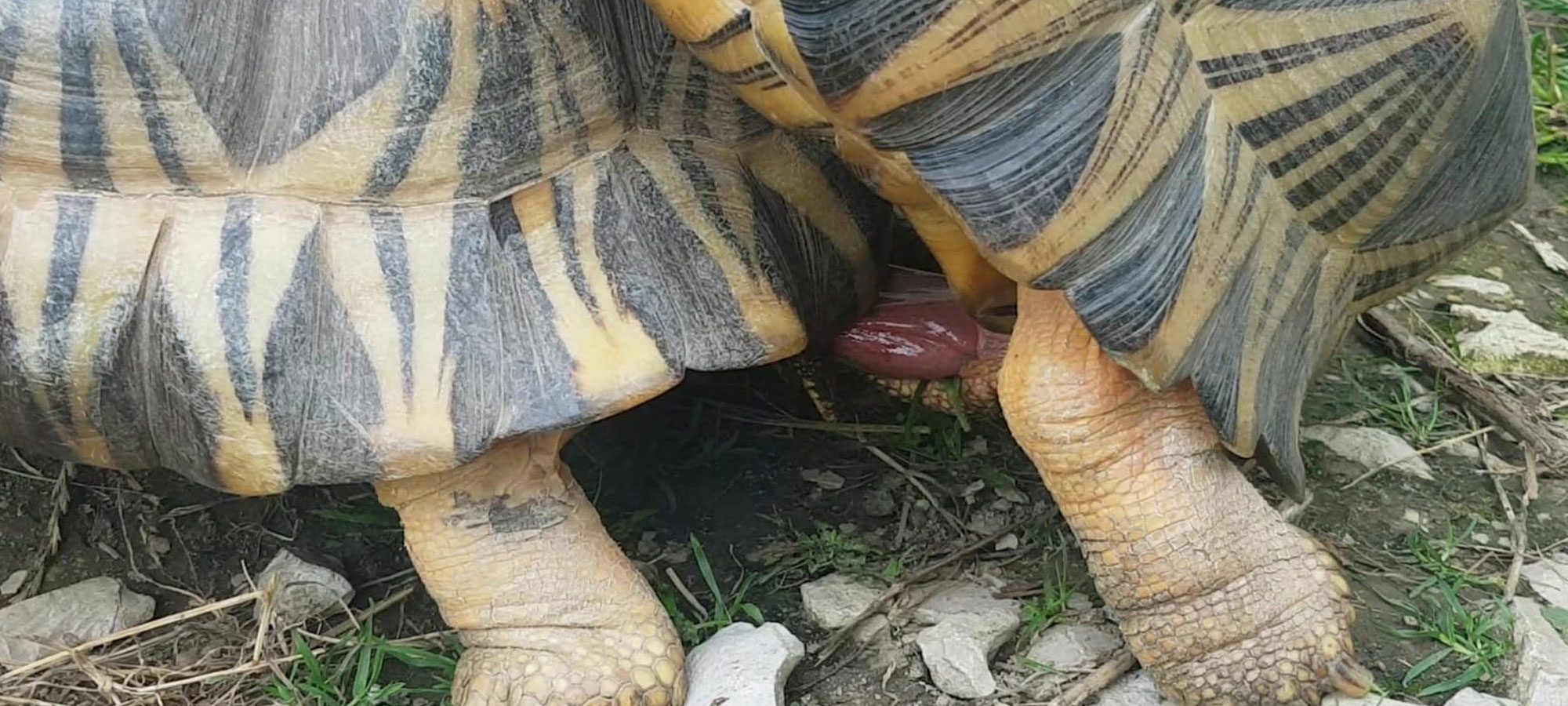Successful matings are rare in Astrochelys radiata
Sexually mature females exude a secretion via the cloaca that attracts males roaming the territory. During the mating season, females are often pursued and harassed for hours by a male. The male jostles the female from the side and tries to make her stand still. Again and again the male tries to fix the female with his body weight on the ground by riding up from behind. While riding up, the male tries to feel the female's cloaca with the end nail on his sickle-shaped tail. With short, rhythmic thrusts, he then tries to push his cloacal opening as close as possible to that of the female. In sexual arousal, it emits fiepende and gasping sounds, which are audible far away. The clashing of the carapaces also causes a pounding sound. Most of these mating attempts are unsuccessful, however, and the female continues unimpressed, evading further stormy approaches by the male by running away and hiding. Mating females, on the other hand, remain stationary and raise their abdominal carapace slightly. In doing so, they extend the tail backward and relax the cloaca to allow the male to copulate. Mating ray turtles may remain in the copulatory position for several minutes before separating. However, successful matings in which the male succeeds in inserting the penis into the female's cloaca are relatively rare.
In care, one can support the mating process by avoiding any kind of disturbance. Separation from uninvolved and curious conspecifics is also recommended. A non-slip bottom substrate provides good footing during the act. The longer the pair remains in the copulation position, the more likely is a successful fertilization. We could observe successful matings with our animals mainly in the late afternoon or in the early evening hours. Sultry weather conditions, before or after a summer thunderstorm, seem to be especially favorable. In general, the conditions for successful mating of Astrochelys radiata seem to be much better in a sunny, natural outdoor enclosure than in an indoor enclosure. We assume that the animals are better activated and stimulated by direct sunlight.
We have observed that in our population the same pairs find each other again and again. Both males and females seem to have certain preferences despite having a choice of several potential mates. Since the selection criteria and preferences of each individual are difficult to interpret, assembling a harmonious breeding group is not always easy. Trying to put breeding pairs together according to one's own liking clearly results in a lower fertilization rate. If ray turtles of both sexes are kept under low-stimulus conditions (e.g. moderate temperatures and humidity) mating does not occur. It is therefore quite possible to keep male-only groups of Astrochelys radiata peacefully and stress-free under low-stimulus conditions and sufficiently large space. On the other hand, mating can be easily forced in a breeding program if the temperature and humidity are artificially regulated upwards and the turtles are exposed to daylight at the same time.
Females of Astrochelys radiata do not cycle under suboptimal husbandry conditions. Especially the lack of natural sunlight has a negative effect on the egg maturation process. This can be stopped hormonally under unfavorable conditions and immature egg follicles are reabsorbed by the body. Female Radiated Tortoises can store sperm from different males in their bodies, so fertilized clutches can still occur years later. Only sexually mature females mated by males lay eggs.
Males probably cannot successfully reproduce until they reach a certain size and weight and have gained experience. Males that are larger and heavier than the female are less likely to be ignored and shaken off by the female during mating attempts. The chances of successful fertilization are increased many times over with several large and potent males in a group.
FAQ on the topic of mating
For a targeted and regular breeding of Astrochelys radiata you need above all patience and perseverance. If a group of Radiated Tortoises is already raised together as young animals, the animals sometimes get used to each other under relatively low-stimulus and constant conditions, like an old married couple, in such a way that they turn out to be regular mating muffle even though they have reached sexual maturity. We therefore recommend to make the daily life of the animals more "stimulating". Raising the temperature to 30-35°C and humidity to 80%, as well as regular exposure to the sun and fresh air will work wonders. Separating the sexes for several weeks without the animals being able to see and smell each other also has a very stimulating effect when they meet again. Considering the ritualized mating behavior of the animals, the presence of several males is also beneficial. Critically check whether all husbandry parameters have been implemented consistently. If none of the measures should be effective after several repetitions, a new composition of the group with exchange of single specimens is to be considered. In rare cases an inflammation and degeneration of the ovaries caused by viruses or bacteria can occur with irreversible infertility. We consider a regular breeding program of Astrochelys radiata in an indoor environment, without access to natural sunlight, to be out of the question.

